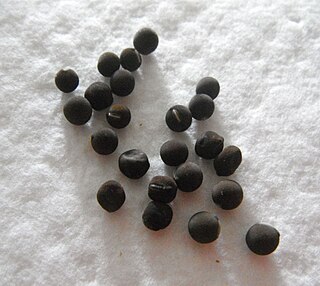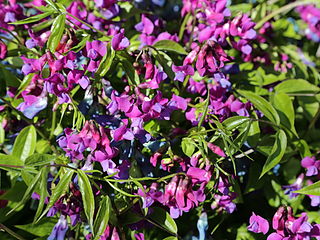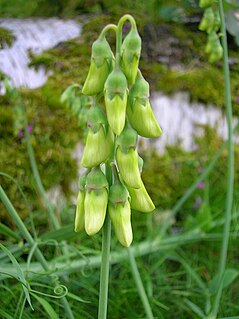
Lathyrus is a genus of flowering plants in the legume family Fabaceae, and contains approximately 160 species. Commonly known as peavines or vetchlings, they are native to temperate areas, with a breakdown of 52 species in Europe, 30 species in North America, 78 in Asia, 24 in tropical East Africa, and 24 in temperate South America. There are annual and perennial species which may be climbing or bushy. This genus has numerous sections, including Orobus, which was once a separate genus.

Lathyrus latifolius, the perennial peavine, perennial pea, broad-leaved everlasting-pea, or just everlasting pea, is a robust, sprawling herbaceous perennial flowering plant in the pea family Fabaceae. It is native to Europe but is present on other continents, such as North America and Australia, where it is most often seen along roadsides.

Lathyrus sativus, also known as grass pea, cicerchia, blue sweet pea, chickling pea, chickling vetch, Indian pea, white pea and white vetch, is a legume commonly grown for human consumption and livestock feed in Asia and East Africa. It is a particularly important crop in areas that are prone to drought and famine, and is thought of as an 'insurance crop' as it produces reliable yields when all other crops fail. The Serra de'Conti Cicerchia is included in the Ark of Taste.

Lathyrus pratensis or meadow vetchling, yellow pea, meadow pea and meadow pea-vine, is a perennial legume that grows to 1.2 m in height.

Lathyrus tuberosus is a small, climbing perennial plant, native in moist temperate parts of Europe and Western Asia. The plant is a trailer or weak climber, supported by tendrils, growing to 1.2 m tall. The leaves are pinnate, with two leaflets and a branched twining tendril at the apex of the petiole. Its flowers are hermaphroditic, pollinated by bees. The plants can also spread vegetatively from the root system.

The sweet pea, Lathyrus odoratus, is a flowering plant in the genus Lathyrus in the family Fabaceae (legumes), native to Sicily, southern Italy and the Aegean Islands.

Lathyrus vernus, the spring vetchling, spring pea, or spring vetch, is a species of flowering herbaceous perennial plant in the genus Lathyrus, native to forests of Europe and Siberia. It forms a dense clump of pointed leaves with purple flowers in spring, shading to a greenish-blue with age.

Lathyrus splendens is a species of wild pea known by the common names pride of California and Campo pea. It is native to Baja California and its range extends into San Diego County, California, where it grows in the chaparral. This is a climbing perennial pea vine with coiling tendrils. Its leaves are each made up of 6 to 8 linear to oval-shaped leaflets a few centimeters long and wavy-margined stipules. The plant produces showy inflorescences of up to 6 bright to deep red flowers each about 3 centimeters wide. The fruit is a hairless dehiscent legume pod.

Lathyrus sulphureus is a species of wild pea known by the common names snub pea and sulphur pea.

Aminopropionitrile, also known as β-aminopropionitrile (BAPN), is an organic compound with both amine and nitrile functional groups. It is a colourless liquid. The compound occurs naturally and is of interest in the biomedical community.

Lathyrus rigidus is a species of wild pea known by the common name stiff pea. It is native to the Modoc Plateau and surrounding areas in the western United States from northeastern California to Idaho. It is a plant of the sagebrush scrub and other habitat in the region. This is a perennial herb forming a clump of short, erect stems. The leaves are made up of several pairs of leaflets 1 to 3 centimeters long each. The inflorescence is a dense raceme of 2 to 5 white or pink pea flowers each roughly 2 centimeters long. The fruit is a hairless legume pod.

Lathyrus sphaericus is a species of wild pea known by the common names grass pea and round-seeded vetchling. It is native to Eurasia and much of Africa, and it is known on other continents as an introduced species. It can grow in many types of habitat, including disturbed areas. This is an annual herb producing a slender stem and bearing leaves each made up of two long, narrow, grasslike leaflets up to 6 centimeters long and a coiling, climbing tendril. The inflorescence is made up of one pea flower on a stalk one or two centimeters long ending a in a bristle. The flower is roughly a centimeter long and deep orange-red or dull red in color. The fruit is a hairless legume pod marked with longitudinal stripes.

Lathyrus linifolius is a species of pea, commonly called bitter vetch or heath pea. The name bitter vetch is also sometimes used for Vicia ervilia and also for Vicia orobus. The tubers of Lathyrus linifolius were formerly used as an appetite suppressant in medieval Scotland, and this use has brought the plant to recent medical attention. Attempts are being made to cultivate the plant on a commercial scale.
Melanoplus inconspicuus, the inconspicuous spur-throat grasshopper, is a species of spur-throated grasshopper in the family Acrididae. It is found in North America.
Lathyrism is a condition, caused by eating certain legumes of the genus Lathyrus. There are three types of lathyrism: neurolathyrism, osteolathyrism, and angiolathyrism, all of which are permanent but differ in symptoms and the affected tissues.
Hypericum australe is a species of plants in the family Hypericaceae. Individuals can grow to 24 cm tall.

Lathyrus annuus is a species of annual herb in the family Fabaceae. They are climbers and are associated with freshwater habitat. They have broad leaves. Individuals can grow to 37 cm tall.
Lathyrus gorgoni is a species of annual herb in the family Fabaceae. They have a self-supporting growth form and compound, broad leaves. Individuals can grow to 38 cm.

Lathyrus ochrus is a species of annual herb in the family Fabaceae. They are climbers and have compound, broad leaves. Flowers are visited by Old World Swallowtail and Oxythyrea funesta.

Lathyrus setifolius is a species of annual herb in the family Fabaceae. They have a self-supporting growth form and compound, broad leaves. Individuals can grow to 31 cm.
















